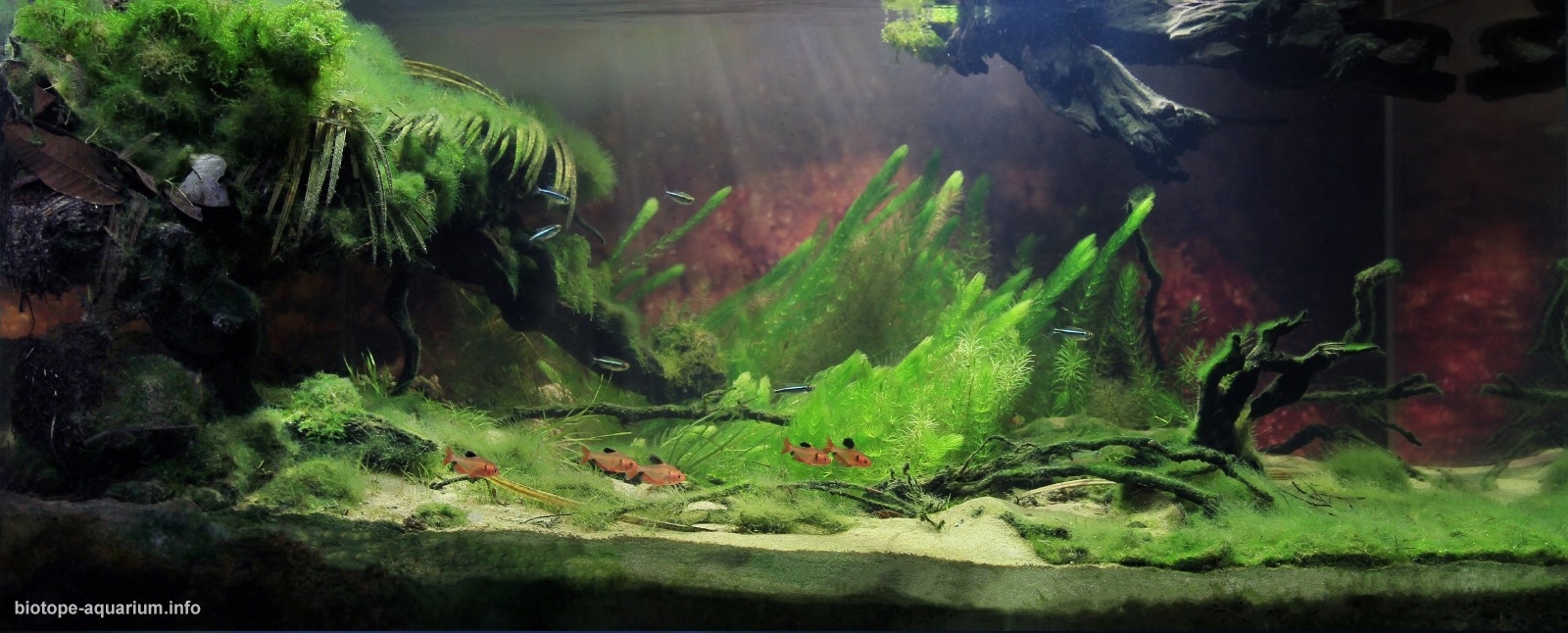A tributary of Taquari river, near the town of Coxim, Mato Grosso do Sul, Brazil
_th place in Biotope Aquarium Design Contest 2020

Volume: 243 L
Dimensions: 90x60x45 cm
List of fishes: Hyphessobrycon eques, Hyphessobrycon herbertaxelrodi, Aphyocharax rathbuni
List of plants: Myriophyllum sp., Ceratophyllum demersum, Mayaca fluviatilis, Cyperus sp., Eleocharis parvula
Description of decorations: The photos I took before, lacking agility and substitution, can only show a moment of the underwater landscape in the aquarium. When I made this biotope aquarium, I had an idea of expressing the real flowing underwater landscape in a static photo by swinging of underwater plants through water flow. Therefore, I installed two strip-shaped wave pumps in the aquarium and hid them under the shelf made of driftwood. Thanks to the blow action (blowing function) of the water pump, the underwater plants sway with the current, and the fish swim against the current, just like what they do in their natural habitat.
All the elements used in my aquarium, including branches and fallen leaves, were derived from natural collection. I chose white fine sand as the substrates which is consistent with that in the habitat.
Description of equipment: Kessil Tuna Sun 360x 90w LED, Spectrum 6,000K to 9,000K (2), EHEIM professional 4 350 filter 1050L/H, EHEIM 600 classic external filter (1000 L/H), Laoyujiang water pump CX-WS 15w 1500-5000L/H (2)
Water parameters: Aquarium water looks clear. The aquarium is kept at room temperature which is about 24-26°C at this time of year. pH is 6.8.
INFORMATION ABOUT BIOTOPE
Description of the area surrounding the biotope: The habitat I described is belongs to a tributary of Taquari river which is near the town of Coxim, in south-central Mato Grosso do Sul, Brazil. The coordinates of Coxim are S 18° 30′ 24″ and W 54° 45′ 36″.
The Pantanal is the largest complex of wetlands in the world, and it is part of the Upper Paraguai River Basin. The Pantanal wetlands comprise nearly 250,000 km2. The Taquari is one of its largest rivers which has a length of about 800 km and about 500 km of it is in the wetlands of the Pantanal. The size of the high Taquari River basin is 29,000 km2, and the area of the river basin in the Pantanal is about 50,000 km2. The Taquari is unique in the world, because it has the largest alluvial fan in the world, and it is a natural river showing all its characteristics.
Description of the underwater landscape of the biotope: The substrate of the river is fine white sand, which makes the river clear and transparent. Roots, branches and leaves fall into the river and gather in the slow-flowing area, provide shelters for inhabited fishes. There are plenty of aquatic plants, e.g. Myriophyllum sp., Ceratophyllum demersum, Mayaca fluviatilis, Cyperus sp., and Eleocharis parvula. When the rainy season comes, the river will flood the area on the shore, and more terrestrial plants will be submerged in the water, providing additional shelters and food for fish.
Description of the parameters of the habitat: The climate is relatively warm and sometimes hot. The annual average temperature of Coxim is 31.5 °C. October is the warmest month on average. June is the coolest month on average. The rainy season, with most rain falling between November and March, is from May to October, the land dries out, and grasslands and scattered pools appear. The water is clear and the pH is about 6.8 in dry season. During the rainy season, rising rivers will flood some of the plants and soil on the shore, the pH will go lower.
List of fishes and invertebrates occurring in the nature biotope: Hyphessobrycon eques, Hyphessobrycon herbertaxelrodi, Aphyocharax rathbuni
List of plants found in the nature biotope: Myriophyllum sp., Ceratophyllum demersum, Mayaca fluviatilis, Cyperus sp., Eleocharis parvula
Threats to the ecology: Pantanal, the paradise, seems under threat. The landscape of the highlands that surround the Pantanal, the Planalto is part of the biogeographic zone of the Cerrado. The Cerrado biome is situated south of the Amazone from the dry northeast to the Pantanal. It consists of poor soils, fine sand and silt with low organic content. It is highly erosive and its soil can easily be taken away by rain or wind. In the upper Taquari, the erosive area is about 13,380 km2 (46 % of its area). A considerable change has taken place in land use. The loss of soil is serious on an area of 12,603 km2 (44 % of the high catchment). The yearly average potential loss here at present is 556 tonnes/ha. This results in a sediment discharge at Coxim in 1995 of 2000 m3 per day.
The sanding up of the Rio Taquari at the moment is a major problem, because of the nearly permanent inundation of large area in a region of about 11,000 km2 in the sub-region Paiaguás. Solving that problem is difficult as there is no coherent river management organization and the nature of the river, especially in the lower reach, is unknown. The knowledge to make decisions for tackling both problems is lacking. It is the challenge of this project that to deliver that knowledge.
The main problem that has been indicated by the people living in the area of the Pantanal has been the national colonization in the 1970s that had completely changed the land cover and land use of the Planalto. This is where they search the main cause of their present problems.
Sources of information:
[1] A tributary of Taquari river, near the town of Coxim
https://mp.weixin.qq.com/s?__
[2] Alho, CJR. Biodiversity of the Pantanal- response to seasonal flooding regime and to environmental degradation
[3] R.H.G. Jongman, Pantanal-Taquari; Tools for decision making in Integrated Water Management
[4] Jonker, R. N. J., The hydrologic system of the Taquari River. MSc Thesis, University of Twente, The Netherlands
[5] Mario LuisAssine, River avulsions on the Taquari megafan, Pantanal wetland, Brazil, Geomorphology
